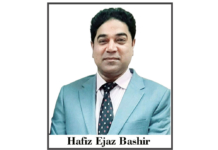At a private institution in Lahore, I recently had a chance to attend an important debate based on the topic of ‘Is Urdu a Colonial Language’? The enthusiasm expressed by student despite reflecting their engagement with the topic also shed light on the controversies surrounding the role of languages in Pakistan, and the confused perceptions of the youth.
The session started with a briefing by the student organizer. He presented a brief history of Urdu and the very important role played by linguist John Gilchrist, in turning Urdu into a significant language. In his view, this was clear for a majority of people in the subcontinent. Hence, the colonial administrators understood this language as a tool for establishing their rule. Nevertheless, at the time of partition, this language was also identified with the Muslim identity. This heated discussion resulted in an argument and counter argument based on the role of Urdu language during the Pakistan movement and how it impacted the influence of this language in postcolonial Pakistan.
When the forum was opened for debate by the students, various complex points were raised in favor of and against the role of Urdu in Pakistan:
Those who argued in favor of Urdu suggested that the manner of evolution and progression of Urdu is the same as any other language and hence a natural process, so why debate this? While others agreed that that learning Urdu in schools does not threaten other linguistic identities in Pakistan. A few argued that the popularity of a language is based on its economic value, and from that perspective, we can say even Urdu does not have that economic value that English still maintains.
The controversies surrounding this discussion were multiple. For instance, an important argument was that Urdu was being used as a means for mobilizing Muslims at the time of partition. A few argued that Urdu was purposefully created this way so that the minority can rule and it has the same role in postcolonial Pakistan.
A few questioned that if Urdu-speaking people were fewer in number than speakers of other languages then how can one assume that it can integrate people and keep them together?
A student argued that Urdu language includes Persian words because at that stage in history, the official language was Persian. Hence, how do we disassociate Urdu from Persian?
One argument was the long-term impact of Urdu as a national language. For instance, a student argued that Urdu was the basis of the separation of East and West Pakistan. Youth belonging to various ethnicities of Pakistan debated that Urdu does not represent the people living in Pakistan but was imposed upon them. A student said that in his school he was taught to read Urdu and not his native language; thus, he ended up blaming the system that has forcibly made youngsters incapable of reading their rich native languages. Another student argued that various local languages were not supported as a state policy to assert the dominating role of Urdu and, ironically, also English that still reflects the colonial legacy.
Some proposed that when you compare the languages of Pakistan to the neighboring country, the latter have their own industries and can start movements using their media focused on local languages. Whereas, in Pakistan, it is impossible that a local media channel can get the same repute as many private channels focused on Urdu language enjoy. They argued that the present condition of the regional languages is not because of the dominance of Urdu but because Urdu is prominently projected through print and social media as well as dramas.
Overall, despite important questions raised during this session, the youth argued that the debate is too complicated and controversial for discussion.
The initiative taken by the organizer of this forum was important. Nevertheless, one wonders at the ambiguities overpowering these young minds and how they can be clarified. The versions of history that they have been taught through conventional institutions and language policies at some level clash with the academic freedom that they have in progressive institutions of higher education.
Nevertheless, the confusion persists as there is ambiguity reflecting through the policies implemented in the country that may be biased when it comes to diverse languages that also reflect the diversity of identities in Pakistan.






